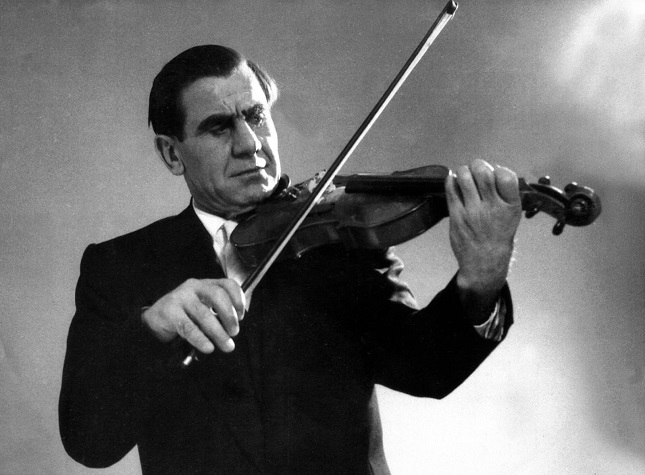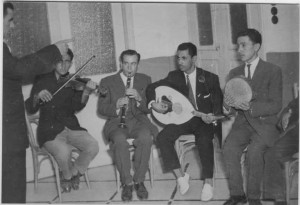Gabriel Asaad: Pioneer of Syriac Music and Voice of Identity
A series about influential Syriacs in the modern history of Syria
In the ancient alleys of Midyat in the Tur Abdin region, Gabriel Asaad was born on March 18, 1907, destined to become one of the pillars of Syriac music in the 20th century. Gabriel was more than a musician or composer; he was the voice of a people, a carrier of their heritage and identity. Blending the spirit of the East with Western influences, he created a timeless musical legacy that continues to resonate today.
Beginnings Marked by Travel and Inspiration
Gabriel’s childhood was far from settled. In 1914, his family relocated to Adana, where his musical journey began. At the Syriac orphanage school (Taw Mim Simkat) there, he learned the basics of the Syriac, Turkish, and French languages, immersing himself in traditional hymns that blended Syriac melodies with Turkish and Armenian flavors. Those early years planted the seeds of his passion for music, particularly the hymns of the Syriac Orthodox Church, which later became his deepest source of inspiration.
As his family moved to Tripoli, Lebanon, then Homs, and finally settled in Daramsuq (Damascus), Gabriel began carving his path toward musical mastery. In Damascus, he studied the violin under an Armenian teacher, honing his skills and mastering the instrument. For Gabriel, the violin was not just a tool for playing music but a voice that expressed his roots and history, carrying the melodies of the church and the soul of the Syriac people.
A Journey of Creativity: From Beirut to Palestine
In 1926, Gabriel moved to Beirut, where he unleashed his musical talent, composing his first national works. His melodies carried a clear message: preserving Syriac identity, language, and heritage. From Beirut, he traveled to Palestine, where his work took a significant leap. There, he immortalized the 1933 Simele massacre through poignant musical compositions and produced the first-ever Syriac record, featuring two national anthems, marking him as a pioneer in documenting Syriac music.
Zalin (Qamishli): The Heartbeat of Music
In the 1950s, Gabriel settled in Zalin (Qamishli), Syria, where his career reached its peak. He headed the music department at the cultural center and founded a music school that became a beacon for Syriac musical education. Under his guidance, notable musicians like Fr George Cacan and Joseph Malki were trained, transforming Zalin (Qamishli) into a vibrant cultural hub. During this period, Gabriel published his first book, From Our Modern Syriac Hymns, in Holeb (Aleppo) in 1953, which included 16 anthems based on works by prominent Syriac poets, becoming a cornerstone of national music.
Blending East and West
Gabriel’s melodies were distinguished by a unique style that combined the enchanting Byzantine tradition with Western influences. His passion for both Eastern and Western music allowed him to create national anthems with a global appeal. In his later years, he explored romantic melodies in the popular Syriac (Edessan) dialect, adding a new dimension to his legacy.
In 1974, he released a record in Beirut featuring two of his compositions, reflecting the depth of his musical vision. Gabriel didn’t merely compose; he lived the poems he chose, studying their meanings deeply and crafting melodies that matched their spirit, whether they were spirited or melancholic.
Sweden: The Final Legacy
In 1979, Gabriel migrated to Sweden, where he continued his creative journey. There, he published his second book, Syriac Music Through History, in 1990, a comprehensive work exploring the origins of musical modes in Beth Nahrin (Mesopotamia) and his remarkable discovery of the lost ancient Syriac musical scale. This discovery, presented at the Fifth Syriac Studies Conference in Belgium, solidified his status as a musicologist and historian alongside his role as a composer.
His contributions extended beyond music, as he authored historical books about the Syriac people, such as History of the Syriac Abgarid Kings and The Syriacs and Their Religious Issues, reflecting his dedication to preserving Syriac identity in all its dimensions.
A Lasting Legacy
Dr. Abrohom Lahdo, who knew him, said, “Gabriel sensed a lack of original Syriac melodies and took poems by great poets like Archbishop Yuhanon Dolabani and Denho Maqdisi Elias, giving them new melodies that became the foundation of classical Syriac singing.” Dozens of songs he composed between 1926 and 1960 are still sung today, a testament to his genius.
Gabriel Asaad passed away in Sweden on July 6, 1997, at the age of 90, leaving behind an indelible musical and cultural legacy. His son, musician Sardanbal Asaad, documented his traditional and national songs to preserve them for future generations. Gabriel was not just a musician but a guardian of Syriac identity, blending nostalgia for roots with aspirations for universality. His name remains etched in the history of Syriac music as a true pioneer and the father of the modern Syriac song.
“Our beloved motherland, our goal” sung by Yusuf Shamun and Evlin Dawud. Music composed by Gabriel Assad.
In this series
A Voice Unsilenced: The Journey of Saeed Malki
The Light of the Gozarto: The Epic of Joseph Bahdi Keryo
Mayada Bselis: The Authentic Syriac Voice and Pioneer of Syrian Art
Selim Hanna: The Journey of a Syrian Syriac Artist in the World of Theater and Drama
Iskander Aziz: An Icon of Syrian and Syriac Art
Nouri Iskandar: Ambassador of Syriac Eastern Music and Chronicler of Its Heritage
The Syriac Asfar-Najjar Family: pioneers of Syrian agriculture in a journey through time
Youssef Abdelké: A Visionary Syriac Artist Blending Creativity and Commitment
Yaqub Keryo: The Syriac Journalist and Thinker Who Carried the Torch of Nationalism and Culture
Saeed Ishaq: The Silent Statesman Who Left His Mark on History
The Saga of Bahdi Keryo: A Leader Forged in Fire
Hanna Yaqub Abdulki (1877-1955): The Life of a Man Who Shaped History
























